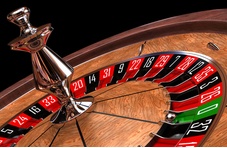The New Zealand online casino makes no secret of the fact that there’s a house edge that gives the house a significant advantage over roulette players. Roulette is one of the most popular games at any casino but the odds are always in favor of the casino, both for European roulette and, even more so, for American roulette.
For one physics maven, that fact was just a hurdle to overcome. J. Doyne Farmer succeeded in building a machine in the ‘70s that allowed him to skew the odds in his favor. His machine worked so well that he was banned from all of Nevada’s casinos.
For 50 years, Farmer’s invention was kept secret. Now, thanks to University of California, Berkeley, professor Richard Muller, the murky story of Farmer’s invention can be told. Note, the "system" only worked on land-based roulette where physics is a factor. In our online casino roulette, results are determined by the random number generator. But let's see what can be done at a land-based game.....
J.Doyne Farmer
J. Doyne Farmer was born in 1952 and grew up in New Mexico. He was influenced by Tom Ingerson, a Boy Scout leader and physicist. Ingerson inspired Farmer to pursue both science and adventure. Among other activities, the troop searched abandoned Spanish goldmines to fund missions to Mars.
Farmer went on to study physics, first at Stanford and then, for his graduate studies, at the University of California, Santa Cruz under George Blumenthal.
Beating Roulette
Farmer teamed up with Norman Packard, a childhood friend, to form a group called Eudaemonic Enterprises. Their goal was to find a math-based solution that would allow them to beat the roulette wheel. The word “eudemonia” comes from Greek and refers to a state of enlightenment that derives from a life lived in accordance with reason.
They began their project with a roulette wheel and examined the theoretical and experimental physics of the wheel. They reasoned that, in order to encourage people to bet at roulette, the casino will accept bets made after the wheel is spun and the ball is tossed but only before it begins to drop. Packard and Farmer reasoned that, within that second or two, enough information can be gathered to allow a measurement and computation that will increase the odds of a winning spin.
The theory was that, since computation simply rules out half of the wheel as unlikely, the odds jump up in the player’s favor. Whereas prior to the computation, the player’s odds of winning were approximately 98:100, if half the numbers were excluded the odds become 196:100; big win!
In this system, there’s no need to predict the number where the ball will fall. A 3 percent increase in odds is enough to go from an average of losing to an average of winning.
Wearable Digital Computer
Farmer and Packard set out to test their system. They build a wearable digital computer – the first ever built in the world – and Farmer coded the three-kilobyte program. Within the program there was a floating-point package, an operating system that functioned with vibrating outputs and toe inputs and a sequencer that was set to perform the calculations. At first, the wearer would have the computer hidden under his armpit but a later version was built to be concealed in a shoe.
The goal of the machine was to measure position and velocity of the ball and rotor during the 10 seconds that elapsed from the time that the dealer released the ball until the betting table stopped taking bets.
Once the position and velocity of the ball and rotor was measured, the computer could use the information to predict the most likely position in which the ball would land. The computer would signal the second person who would quickly place the wager.
Theory in Practice
Farmer and Packard achieved a 20% advantage over the house. However, they experienced persistent hardware problems and, combined with a fear of casino retribution, they deemed it prudent to end their experiment.
However, in 2012, researchers Michael Small from the University of Western Australia, and Chi Kong Tse from Hong Kong Polytechnic University, demonstrated that, even before the ball starts bouncing, simply knowing the rate at which the wheel and ball are spinning can skew the odds.
Small and Tse published their paper in a peer-reviewed journal where they recorded how, using a similar system and recording each time the wheel or ball passed a certain point, they won on average 18 percent of the time. That’s well above the negative 2.7 percent that’s expected from a random bet. "Knowing the initial conditions allows you to beat the odds," said Small. "In some cases you can beat them quite significantly."
Response
Until the 2012 publication was released, Farmer had never publicly discussed his project. However, after Tse and Small’s paper was made public, Farmer admitted that their technique was similar to his own 1970s experiment. The one big difference was that Tse and Small assumed that friction with the rim was the main force that slowed the ball down while Farmer had calculated that it was air resistance.
Both Farmer and Packard have gone on to illustrious careers in physics. However, their work on roulette and adventures in the Nevada casinos was featured in the 2004 Breaking Vegas documentary “Beat the Wheel.”




